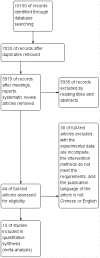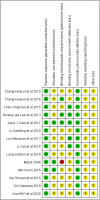The difference between the effectiveness of body-weight-supported treadmill training combined with functional electrical stimulation and sole body-weight-supported treadmill training for improving gait parameters in stroke patients: A systematic review and meta-analysis
- PMID: 36438963
- PMCID: PMC9682182
- DOI: 10.3389/fneur.2022.1003723
The difference between the effectiveness of body-weight-supported treadmill training combined with functional electrical stimulation and sole body-weight-supported treadmill training for improving gait parameters in stroke patients: A systematic review and meta-analysis
Abstract
Background: Body-weight-supported treadmill training (BWSTT) combined with functional electrical stimulation (FES) is considered an effective intervention method to improve gait parameters in stroke patients. In this article, we compared the effect of BWSTT combined with FES and BWSTT only on gait parameters in stroke patients.
Methods: Two researchers searched for literature published before January 5, 2021, in seven Chinese and English databases including PubMed, Web of Science, Cochrane Library, Ovid, CNKI, Wanfang Data, and VIP. Meta-analysis was then performed on various data collected, namely, 10 Meters Walking Test (10MWT), gait speed, Fugl-Meyer Assessment (FMA), Berg Balance Scale (BBS), Modified Barthel Index (MBI), Comprehensive Spasticity Scale (CSS), Functional Ambulation Category (FAC), and Ankle Range of Motion (AROM).
Results: A total of 14 studies were included in the meta-analysis, in which 945 stroke patients participated. In these 14 studies, the participants were randomly divided into a test group and a control group. The test group received BWSTT combined with FES, while the control group received BWSTT only. Meta-analysis showed that when compared to BWSTT, BWSTT combined with FES had a better effect on FAC, AROM, 10MWT, CSS, MBI, FMA, gait speed, and BBS of stroke patients. However, the effect of BWSTT combined with FES on BBS was not significant in the medium exercise group when compared to that of BWSTT. Also, the effect of BWSTT combined with FES on gait speed was not significant in the large exercise group when compared to that of BWSTT only.
Conclusion: BWSTT combined with FES is more effective than BWSTT only for improving gait parameters in stroke patients.
Systematic review registration: https://www.crd.york.ac.uk/prospero/#recordDetails, CRD42022299636.
Keywords: body weight support; functional electrical stimulation; randomized controlled trials; stroke patients; treadmill training.
Copyright © 2022 Wang, Zhao, Gao, Liu, Dong and He.
Conflict of interest statement
The authors declare that the research was conducted in the absence of any commercial or financial relationships that could be construed as a potential conflict of interest.
Figures












Similar articles
-
Effect of functional electrical stimulation plus body weight-supported treadmill training for gait rehabilitation in patients with poststroke: a retrospective case-matched study.Eur J Phys Rehabil Med. 2020 Feb;56(1):34-40. doi: 10.23736/S1973-9087.19.05879-9. Epub 2019 Oct 15. Eur J Phys Rehabil Med. 2020. PMID: 31615194
-
Effect of exoskeleton-assisted Body Weight-Supported Treadmill Training on gait function for patients with chronic stroke: a scoping review.J Neuroeng Rehabil. 2022 Dec 21;19(1):143. doi: 10.1186/s12984-022-01111-6. J Neuroeng Rehabil. 2022. PMID: 36544163 Free PMC article.
-
[Effects of functional electrical stimulation based on normal gait pattern on walking function in subjects with recovery of stroke].Zhonghua Yi Xue Za Zhi. 2016 Aug 2;96(29):2342-6. doi: 10.3760/cma.j.issn.0376-2491.2016.29.012. Zhonghua Yi Xue Za Zhi. 2016. PMID: 27524193 Clinical Trial. Chinese.
-
Body weight-supported treadmill training is no better than overground training for individuals with chronic stroke: a randomized controlled trial.Top Stroke Rehabil. 2014 Nov-Dec;21(6):462-76. doi: 10.1310/tsr2106-462. Top Stroke Rehabil. 2014. PMID: 25467394 Free PMC article. Clinical Trial.
-
Effect of constraint-induced movement therapy on lower extremity motor dysfunction in post-stroke patients: A systematic review and meta-analysis.Front Neurol. 2022 Nov 21;13:1028206. doi: 10.3389/fneur.2022.1028206. eCollection 2022. Front Neurol. 2022. PMID: 36479056 Free PMC article.
Cited by
-
Exploring the Intersection of Geophysics and Diagnostic Imaging in the Health Sciences.Diagnostics (Basel). 2024 Jan 8;14(2):0. doi: 10.3390/diagnostics14020139. Diagnostics (Basel). 2024. PMID: 38248016 Free PMC article. Review.
-
Effect of gait training using Welwalk on gait pattern in individuals with hemiparetic stroke: a cross-sectional study.Front Neurorobot. 2023 Apr 17;17:1151623. doi: 10.3389/fnbot.2023.1151623. eCollection 2023. Front Neurorobot. 2023. PMID: 37139264 Free PMC article.
-
Therapeutic and orthotic effects of an adaptive functional electrical stimulation system on gait biomechanics in participants with stroke.J Neuroeng Rehabil. 2025 Mar 18;22(1):62. doi: 10.1186/s12984-025-01577-0. J Neuroeng Rehabil. 2025. PMID: 40102928 Free PMC article.
-
Effects of body weight support training on balance and walking function in stroke patients: a systematic review and meta-analysis.Front Neurol. 2024 Aug 27;15:1413577. doi: 10.3389/fneur.2024.1413577. eCollection 2024. Front Neurol. 2024. PMID: 39258157 Free PMC article.
-
Effectiveness of Body Weight-Supported Gait Training on Gait and Balance for Motor-Incomplete Spinal Cord Injuries: A Systematic Review with Meta-Analysis.J Clin Med. 2024 Feb 15;13(4):1105. doi: 10.3390/jcm13041105. J Clin Med. 2024. PMID: 38398415 Free PMC article. Review.
References
-
- Wang XH. What do you know about ischemic stroke. Jiangsu Health Care. (2021) 11:12–3. 10.3969/j.issn.1008-7338.2021.11.jswsbj202111009 - DOI
Publication types
LinkOut - more resources
Full Text Sources
Miscellaneous

